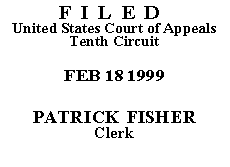 UNITED STATES COURT OF APPEALS
UNITED STATES COURT OF APPEALS
 UNITED STATES COURT OF APPEALS
UNITED STATES COURT OF APPEALS
TENTH CIRCUIT
| SAMUEL DOUGLAS GAGLIANO,
Plaintiff-Appellant, v. STORAGE TECHNOLOGY CORPORATION, a Delaware corporation, Defendant-Appellee. |
No. 97-1235 (D.C. 96-WY-1793-AJ) (District of Colorado) |
ORDER AND JUDGMENT(*)
Before SEYMOUR, Chief Judge, BRORBY, and HENRY, Circuit Judges.
Plaintiff Samuel Gagliano appeals from the grant of summary judgment in favor of the defendant, Storage Technology Corporation, on three employment discrimination claims: (1) age discrimination under the Age Discrimination in Employment Act (ADEA), 29 U.S.C. §§ 621-634; (2) reverse sex discrimination under Title VII of the Civil Rights Act of 1964, 42 U.S.C. § 2000e to 2000e-17; and (3) disability discrimination under the Americans with Disabilities Act (ADA), 29 U.S.C. § 12101-12213. He also appeals from the district court's decision to exclude several proffered exhibits at the trial on his related retaliation claim. We affirm in all respects.
As to the summary judgment rulings, Mr. Gagliano contends that the district court erred in applying the wrong prima facie test with respect to his age discrimination claim, inappropriately required the plaintiff to produce background evidence with respect to his reverse sex discrimination claim, and incorrectly concluded that the plaintiff had not created a prima facie case of disability discrimination. We review the district court's decision de novo, applying the same legal standards pursuant to Fed. R. Civ. Proc. 56(c). See Kaul v. Stephan, 83 F.3d 1208, 1212 (10th Cir. 1996).
After careful review of the record on appeal together with the parties' briefs and the applicable law, we conclude that the district court was correct in determining that Mr. Gagliano had not presented a prima facie case of age discrimination because he did not "produc[e] evidence, circumstantial or direct, from which a factfinder might reasonably conclude that [Storage Technology] intended to discriminate in reaching the decision at issue." Branson v. Price River Coal Co., 853 F.2d 768, 771 (10th Cir. 1988). Mr. Gagliano failed the fourth prong of the familiar McDonnell Douglas analysis for employment discrimination claims. See McDonnell Douglas Corp. v. Green, 411 U.S. 792, 802-04 (1973). Similarly, as to the reverse sex discrimination claim, the district court correctly found that Mr. Gagliano had not presented background evidence supporting the inference that Storage Technology discriminated against men nor sufficient indirect evidence that but for his gender he would not have been terminated. See Notari v. Denver Water Dep't, 971 F.2d 585, 588-89 (10th Cir. 1992). As to the ADA claim, the district court also correctly found that Mr. Gagliano had not established a prima facie case because he did not show that he had a disability under the ADA's statutory definition. See 42 U.S.C. § 12102(2); Bolton v. Scrivner, Inc., 36 F.3d 939, 942 (10th Cir. 1994). Therefore, for substantially the same reasons as stated in the district court's oral ruling on February 27, 1997 and its subsequent written order dated March 5, 1997, we conclude that Storage Technology is entitled to summary judgment on Mr. Gagliano's employment discrimination claims.
As to the retaliation claim that proceeded to trial, Mr. Gagliano argues that the district court improperly excluded letters and memoranda written by him to Storage Technology representatives during the course of his internal appeal. He challenges the district court's ruling that these proffered exhibits were not contemporaneous, were hearsay, and were potentially misleading because they contained references to the previously dismissed employment discrimination claims. Mr. Gagliano also contends that although the district court subsequently admitted redacted versions of two of these exhibits, it improperly excluded two other redacted exhibits as not contemporaneous hearsay. Mr. Gagliano argues that the exhibits should have been admitted under the residual hearsay exception, Fed. R. Evid. 803(24), as contemporaneous writings, or under the business records hearsay exception, Fed. R. Evid. 803(6).
We review a district court's decision to exclude evidence for an abuse of discretion. See Cartier v. Jackson, 59 F.3d 1046, 1048 (10th Cir. 1995). Here, the original exhibits contained numerous hearsay statements and references to the dismissed discrimination claims. Further, the district court correctly observed that Mr. Gagliano was capable of testifying to the same material. Accordingly, the district court did not abuse its discretion in excluding the original exhibits. Additionally, the two redacted exhibits excluded by the district court were not contemporaneous to the retaliation events, did not bear the necessary hallmarks of reliability under Rule 803(24), and were not business records in any sense of the term. Thus, after careful review of the record, we conclude that the district court did not abuse its discretion in excluding the redacted exhibits.
Accordingly, we AFFIRM the district court's grant of summary judgment in favor of the defendant Storage Technology Corporation on all three of Mr. Gagliano's employment discrimination claims. We also AFFIRM the district court's judgment in favor of Storage Technology Corporation on Mr. Gagliano's retaliation claim.
Entered for the Court,
Robert H. Henry
Circuit Judge
*. This order and judgment is not binding precedent, except under the doctrines of law of the case, res judicata, and collateral estoppel. The court generally disfavors the citation of orders and judgments; nevertheless, an order and judgment may be cited under the terms and conditions of 10th Cir. R. 36.3.